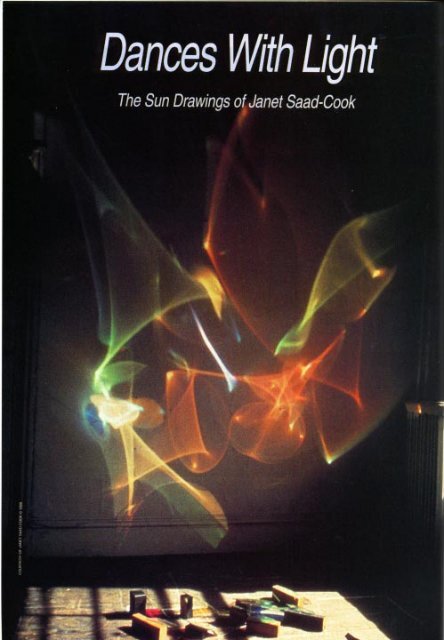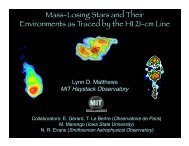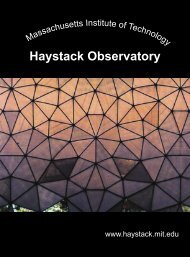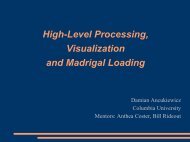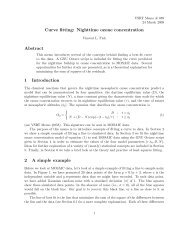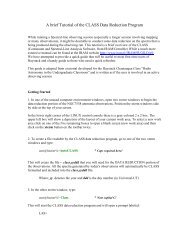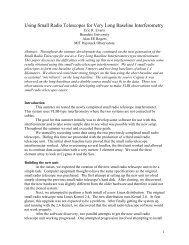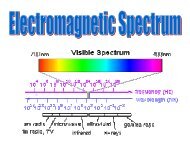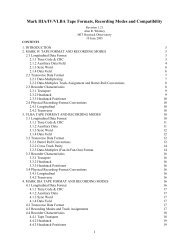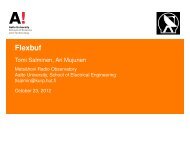Janet Saad-Cook And - MIT Haystack Observatory
Janet Saad-Cook And - MIT Haystack Observatory
Janet Saad-Cook And - MIT Haystack Observatory
- No tags were found...
Create successful ePaper yourself
Turn your PDF publications into a flip-book with our unique Google optimized e-Paper software.
One day in February 1981,artist <strong>Janet</strong> <strong>Saad</strong>-<strong>Cook</strong> wasstrolling through aWashington, D.C.,department store when herattention was riveted by acrumpled piece of iridescentplastic cellophane glitteringin a cosmetics display.Instantly she knew that shehad found an artistic mediumthat would take her into awhole new phase of work.At the time, <strong>Saad</strong>-<strong>Cook</strong> was in a period ofartistic crisis. She hadrecently taken down hermagnum opus, a huge galleryinstallation in a medium shehad been working in forseveral years_flexiblebamboo reeds she gatheredon the banks of the Potomacand wrapped in white gauze,then shaped into fantasticwhite-line structures that onecould walk through as theyextended from room to room,casting dramatic shadows onthe walls. Deep within herselfshe sensed that she had cometo the end of what she coulddo in that medium, and shefelt directionless, spent, andfull of self-doubt. ``I felt thatI had shot my wad, that Iwould never do anything ofvalue again,'' she recalls.<strong>Saad</strong>-<strong>Cook</strong> is ahighly intuitive artist who letsher materials lead her. Whenshe saw that beautiful littlepiece of crumpled iridescentfilm, all she knew was thatshe had to get ahold of someand play with it, to see whereit would take her. Shepurchased a roll of the thennew material the very nextday and, upon unrolling it inher sunlit studio, found to herdelight and wonder that thewalls burst forth in a glory ofreflected light. ``It was likethe whole room was bothunderwater and on fire,'' shesays.Thus commenced apath that would in time resultin the creation of a newartistic medium that <strong>Saad</strong>-<strong>Cook</strong> calls Sun Drawings,created through a process thatshe later patented. Scienceand art here meld to createimages of beauty that attunethe viewer to the harmoniousdance of the cosmos.A Sun Drawing is achanging image of refractedlight, cast onto a surface suchas a wall. To make one, <strong>Saad</strong>-<strong>Cook</strong> shapes and assemblesreflective materials andpositions the reflective unit ina preselected path of directsunlight. As sunlight touchesthe reflective unit or``sculpture,'' an image of lightgradually appears on thesurrounding walls andceiling. This is the SunDrawing. Its image slowlyand subtly changes as, withthe earth's rotation, thesunlight completes itspassage across the reflectiveunit.It is so simple an ideathat one is inclined to feel,``why didn't I think of that?''But in actuality it takesdetailed knowledge of optics,light interference, andastronomy to make asophisticated Sun Drawing.<strong>Saad</strong>-<strong>Cook</strong> uses bothmirrorlike reflective materialsand ones that havemultilayered interferenceBY SUSAN FEGLEY OSMONDA Virginia-based artistuses unpigmented colorsfrom the Sun itself forher palette, in drawingsin light that attuneviewers to cyclic celestialharmonies©Joan MyersRight: Artist <strong>Janet</strong> <strong>Saad</strong>-<strong>Cook</strong>(b. 1946). Front: <strong>Saad</strong>-<strong>Cook</strong>,Distillation (Unmounted), 1988,as seen in the artist's studio.coatings that break the lightinto pure colors. When shefirst started making SunDrawings she used mylar,iridescent plastic films, andDu Pont's Kapton_atransparent gold polyimidefilm used to insulate
spacecrafts and spacesuits.These thin films, however,proved to be too flimsy andunstable, and after about fouryears she discovered a way touse optically coated glass andmirrored steel and bronze,both of which she shapes tomake controlled andpermanent Sun Drawings.These cast and reflect theSun's pure colors_nopigments or stained glass areinvolved.``When people hearthat the colors are pure light,''explains <strong>Saad</strong>-<strong>Cook</strong>, a sunny51-year-old with infectiousenthusiasm and a knack forexplaining complicatedprocesses simply, ``theyimmediately think of a prism.But prismatic colors arecaused by light dispersion_asimple process in which lightcomes through the prism andis dispersed into the wholespectrum [as in a rainbow].But light interference, whichI use, is a much moresophisticated phenomenon inwhich the layering of thinfilms onto the glass surfacepulls certain wavelengths oflight into phase and othersout of phase. So you getseparate colors_you don't getall the colors together. Thisgives me a palette to workwith.''Each piece of glass iscapable of casting two colors:the reflection and itsopposite, the transmission. Ifyou take one of theseoptically coated pieces ofglass and hold it in directsunlight, a certain color, saygreen, will be cast on thewall. This is the reflection,which has bounced off thesurface of the glass. Thetransmission, on the otherhand, is what goes all theway through the glass andcomes out the back. If youhold your hand behind thissame piece of glass you willsee magenta light. What<strong>Saad</strong>-<strong>Cook</strong> does is take amirrored metal such as steelor bronze and use that toreflect the transmission coloronto the same surface thatreceives the original reflectedlight, resulting in theinterplay of two colors andtwo images.``Now, here's whathappens with interferencecolors that doesn't happenwith dispersion,'' continues<strong>Saad</strong>-<strong>Cook</strong>. ``As the angle ofCourtesy of <strong>Janet</strong> <strong>Saad</strong>-<strong>Cook</strong> ©1986■ The reflecting unit or sculpture for Alembic,Oppositelight shifts, the colors shift.This rosy magenta turns intoa red, and the reflection goesfrom a bright vivid green to apale blue-green.''The art of this is inbending the reflectiveelements to get an image.``These are not randomreflections,'' she emphasizes.<strong>Saad</strong>-<strong>Cook</strong> starts with themirrored metals, bendingthem by hand in directsunlight until she arrives at areflection that is promising.She then takes pieces ofglass_they range in shape andsize but are no more that afoot square and about aquarter of an inch thick_thathave been ``sagged'' in a kiln.(Little braces have beenplaced strategically beneathparts of the glass in the kiln;the resulting irregularitymakes a varied, ``textured''reflection possible.) Thesagged glass has also beensent to an optical lab, whereit received thirty layers ofalternating coatings, all doneaccording to <strong>Saad</strong>-<strong>Cook</strong>'sexplicit instructions. Whilebending the metal is aprocess of actually``drawing'' an image in lightreflection, with the glassit's a matter of selection.She will sag many piecesof glass at once and thenchoose the ones she wantsto use. ``But I've learnednever to throw anythingaway,'' she notes.Once <strong>Saad</strong>-<strong>Cook</strong>finds the interplaybetween reflection andtransmission that makesthe best image, shepermanently attaches themetal and glass onto a specialmount whose angle she canalso adjust. This she calls thesculpture, but looking at thefairly flat glass and metalobject_minimalism in theextreme_one can hardlybelieve that from them springsuch dramatic, varied,shimmering images of purecolor.Although <strong>Saad</strong>-<strong>Cook</strong>needs detailed knowledge to
make successful SunDrawings_and it took hermany years to gain thatknowledge_the viewer needsno such understanding. Onesimply delights in the beautyof these etherealimages_dancing ellipses andbirds in flight. The colors areso pure, with bright lines offocused light, that theyresonate to the very soul. Ifeel shot through with energywhile watching these subtlychanging light forms; theyengender a wordlessravishment, as if one's spiritis dancing for joy as innerlight answers unto light.Then, when clouds pass overthe Sun, the image softenspoetically or flickers inmyriad gradations, and one isawed by the infinite nuancesof nature, how living a thing■ Alembic, 1986the universe is. As ifremembering something onceknown but long forgotten,one feels deeply connected tothe cosmos, rooted_anintegral though tiny part ofthe music of the spheres.Placed in the universe'sgeometry, one comes tooneself, centered.It is exactly thesekinds of realizations <strong>Saad</strong>-<strong>Cook</strong> wishes to inspirethrough her art, for she isvitally aware that hers is acosmic canvas. ``The SunDrawings are really not aboutpretty images of light,'' shesays. ``They're about theawareness of the Sun and theEarth, and how the tempo andharmony in the universe isgood for our souls.''Courtesy of <strong>Janet</strong> <strong>Saad</strong>-<strong>Cook</strong> ©1986Gradual Development<strong>Saad</strong>-<strong>Cook</strong> came tothis cosmic canvas onlygradually, through manyyears of developing herself asan artist. She was born in1946 in a small town insoutheastern Ohio namedAdena. At the age of eightshe began studying piano,and in boarding school andlater in college she focusedon becoming a concertpianist. But in her junior yearshe came to a startlingrealization: ``I knew I was acreative artist, but I alsoclearly knew that music wasnot my medium. I did notwant to interpret whatsomebody else created; Iwanted to be the originator. I
also knew that I wanted tocreate art that I could see andtouch.''Upon graduation sheturned to the visual arts,painting for about ten years.Around 1976 she made herfirst three-dimensionalobjects, using bamboo, sisal,gauze, and coffee-bean bags.``Once I moved frompainting to sculpture,'' shenotes, ``it became veryimportant to me that I makethe medium as well as theartwork.''Her firstsculptural workswere what she calledPod Pieces, funerealblack objects madeof stuffed coffeebeanbags that were,in her words, ``verydeathlike but eroticat the same time.''Then in 1978 shemoved to a studiothat had directsunlight. ``I startedusing sunlight as anadditive factor in mysculptures.'' In a series shecalled In Between Spaceshe worked in all white, asnoted above, wrappingbamboo reeds with wetwhite gauze. ``I wantedskinny lines of white. I tookthese white lines and createdhuge ghostly, skeletalsculptures and environmentswith them.''In January 1981 shemounted the large installationmentioned earlier, and upontaking it down went througha period of disheartening selfdoubtas an artist. But thenext month she encounteredthe little wad of iridescentfilm in the department store.``I spent the nextyear literally chasing sunlightaround the studio,'' she says.An important transitionalwork was The Radiating Webof Light. ``One of thematerials I found was thishair-thin iridescent fiber,'' sheremembers. ``I found it insome knitting shop.Obsessive that I am, Iproceeded to literally weave aweb throughout the studio,and then take tiny pieces oftheCourtesy of <strong>Janet</strong> <strong>Saad</strong>-<strong>Cook</strong> ©1995■ April's Full Moon, <strong>Saad</strong>-<strong>Cook</strong>'s 1987photograph of the site of the VLA Sun DrawingProject in New Mexico. The building to house theSun Drawing, part of her global project, has yet tobe constructed.iridescent plastic and stick itup here and there. Then Iwould take gold mylar andshoot sunlight through it.Because the light wouldreflect, shimmering, off thisweb, your eye wouldperceive the complexity inspace. Now when I look atpictures of the Web, I seewhat I wasn't seeing at thetime: As I was shooting thegold light through, there wereimages on the wall. But I wasstill focused on what was inthe space.``I loved that web. Iwould be sitting here still,looking at that web, but forthe fact that in February 1982we had a terrible ice stormand the ceiling fell in![Fortunately, no one wasinside.] It destroyed the Web.It was like somebody had justripped my heart out.``But it was actuallythe best thing that could havehappened. I finally had to letgo. I couldn't just sitthere and adore itanymore.'' After thestudio was cleared outfor repairs, shebrought in only a fewreflective materials.``<strong>And</strong> that's when Isaw it. That's when Ilooked at the lightitself as an object.``I found thatI could make actualshapes in reflection,and I saw that if I leftthem alone the Sunwould change them.''But she went away fora few months, andwhen she returned inthe summer the imageswere gone. She was panicstricken.``I didn't knowanything about the Sun cycle,and there was no sunlight inthere anymore.'' Indesperation she called theAmerican AstronomicalSociety and, in a stroke ofgood fortune, was connectedto astronomer Peter Boyce,who has since become herastronomical adviser.Boyce came to <strong>Saad</strong>-<strong>Cook</strong>'s studio. He advised her
Courtesy of <strong>Janet</strong> <strong>Saad</strong>-<strong>Cook</strong> ©1983to go to some of the ancientSun-marking sites in theSouthwest. ``He told methere were ancient Americanswho were essentially doingwhat I was doing.Empirically they wouldwatch the Sun and use it tomark their calendars, to plant,and do their rituals by. Hesaid, `You'll learn more doingthat than you'll learn in abook.' ''Astronomical StudiesShe ended up doingthree years of astronomicalresearch at ancient NativeAmerican Sun-watching sitesin New Mexico and Utah,then at the pyramids ofTeotihuacán near MexicoCity, often in collaborationwith archaeoastronomers.``What I found there were thehistoric roots of my art,'' shesays. At some sites she set uptemporary Sun Drawings.At one Anasazi site,she recalls, where shewitnessed the summersolstice just after sunrise, ``Iwas particularly aware of theunbroken continuum of timeand the constancy of theSun's cycle. This wasespecially evident in the closeproximity of the petroglyphsmade by different Indiancultures so removed fromeach other in time.'' Shecontinued her astronomicalmarking studies at theeighteenth-centuryobservatories of Jai Singh inDelhi and Jaipur. The artistbecame so proficient in thefield that she was twice■ A temporary Sun Drawing onthe winter solstice window at theAnasazi Sun-marking siteHovenweep Castle in Utah, takenat solar noon of the summersolstice, 1983. <strong>Saad</strong>-<strong>Cook</strong> wasstill using pliable films at thistime.invited to give papers at theprestigious GeneralAssembly of the InternationalAstronomical Union.Meanwhile, theSmithsonian Institutionincluded in a national threeyeartour one of the SunDrawings she did with theflexible materials. Lit byartificial light, it wascontained in a room-sizedbox that viewers peered into.Having the Sun Drawingmoved from site to site,packed and unpacked, made
<strong>Saad</strong>-<strong>Cook</strong> see the need tofind more stable materials.She was alreadyworking with mirroredmetals, but finding a suitablereplacement for the iridescentfilm was a problem. Shesolved it through anotherfortuitous discovery whenshe happened to see a shardof iridescent glass_a beamsplitter_whilevisiting anoptical coating laboratory insearch of a nonreflectivecoating for the clear domesthat she put over her plasticfilm``sculptures.'' Instantlyshe knew this was the kind ofthing she was looking for. Tolearn more about dialectriccoatings and sagging theglass, <strong>Saad</strong>-<strong>Cook</strong> spent a yearas artist-in-residence in thephysics department at theCatholic University ofAmerica in Washington,D.C., in 1985 86.Having at last foundmore durable materials(which also producedbrighter images that couldcarry over greater distances),and having completed herastronomical research, <strong>Saad</strong>-<strong>Cook</strong> embarked on realizinga project she had conceivedseveral years before: the SunDrawing Project. This wouldbe a building that wouldpermanently house a multipleSun Drawing in such a waythat the moving mural oflight could be seen by visitorsyear-round.<strong>Saad</strong>-<strong>Cook</strong> traveledall around New Mexico insearch of a site and foundit_again in a moment ofintuitive discovery_at theNational Radio Astronomy<strong>Observatory</strong>'s Very LargeArray (VLA) on the Plains ofSan Agustin. This is thelargest complex of radiotelescopes on the world. As itturned out, the sameinterference phenomena that<strong>Saad</strong>-<strong>Cook</strong> uses in herdrawings the observatoryuses in the process oftransforming radio wavesfrom deep space into imagesof the past that are visualCourtesy of <strong>Janet</strong> <strong>Saad</strong>-<strong>Cook</strong> ©1997■ The Sun Drawing Athanor at theBoston University Photonics Centerduring installation earlier this year. Aheliostat mirror on the roof casts sunlightto a secondary bank of mirrors high inthe atrium, which throws the light ontothe sculpture on it ten-foot podium.The resulting Sun Drawing is 20ft. x 10ft. on the curved atrium wall. Thesignature image for all Sun Drawings inthe global project, an arc of light, is justbeginning to appearlinks with the history of theuniverse.The director of theVLA was immediatelyreceptive. ``I told him, `Yougive me the land to build iton, and'_then I said a trulystupid thing_`I'll see that themoney gets raised to build it.''' She told him the VLAwould own the building andbe responsible formaintaining it and keeping itopen for visitors. Within twoyears, the National ScienceFoundation approved theproject and <strong>Saad</strong>-<strong>Cook</strong> andsome of her astronomerfriends created the SunFoundation to help raisefunds for it as well as otherprojects that showed theconnection between art andscience. Raising thenecessary funds, however,has proved an arduous (andstill incomplete) task.The project has notyet been erected, but <strong>Saad</strong>-<strong>Cook</strong> sees that as a goodthing, because it has gonethrough many changes as herideas and technical knowhowgrow in sophistication.In 1991 she hired architectEric Owen Moss to helpdesign the project, and thecollaboration is ongoing.Global ScaleIn 1994 <strong>Saad</strong>-<strong>Cook</strong>conceived of extending theSun Drawing Project onto aglobal scale. A necklace ofsites around the world wouldhouse interconnected SunDrawings, each unique butlinked by a common markerthat appears in the image at acertain time when the sun issweeping overhead. Thismarker, now designated as anarc of light, is to be ``passed''from site to site: When itbegins to fade at one site, itappears in the next. ``It helps
■ A work in progress,provisionally titled Analema.you realize,'' says the artist,``that we are allinterconnected, absolutely,whether we want to be ornot.''The first global SunDrawing installation wascompleted at <strong>MIT</strong> <strong>Haystack</strong><strong>Observatory</strong> in Westford,Massachusetts, in 1995. It ishoused in the library. Thesecond, at BostonUniversity's PhotonicsCenter, was completed thisyear and appears daily in thebuilding's atrium. The latterrequired a complex opticalsystem to bring sunlight intothe vast central space. TheSun Drawing there hasquickly become so belovedthat the center has agreed topay for expensive upgrades tothe heliostat (which casts thesunlight onto a bank of threemirrors, which in turn throwit down to the reflective SunDrawing apparatus) so thedrawing can appear forlonger hours_from about 9:00^a.m.^ (EST) until about 3:30^p.m.^_and be brighter andmore sharply focused. Since1991 the VLA has also had aSun Drawing housed in theatrium of its headquartersoffice building in Socorro;although this is not the bigproject that is still planned,<strong>Saad</strong>-<strong>Cook</strong> will incorporatethe arc of light into it by theend of this year.Other sites plannedin France, India, Japan, andAustralia are in variousstages of approval, funding,and development. In Nice,the Sun Drawing will behoused in a subterraneanchamber behind the PetiteMeridian instrument, part ofthe great nineteenth-centuryobservatory complex there.At one of these global projectsites, still undecided, <strong>Saad</strong>-<strong>Cook</strong> will devise some sort ofSun-marking system that willshow where the arc of light isat any given time.In the meantime,Courtesy of <strong>Janet</strong> <strong>Saad</strong>-<strong>Cook</strong> ©1997<strong>Saad</strong>-<strong>Cook</strong> does SunDrawings for private homesand companies. Each work issite-specific. People find aSun Drawing calms them andhelps them get in tune with``the big picture.''``In my work,''says<strong>Saad</strong>-<strong>Cook</strong>, ``I want to takethe cycle of the Sun andmake it a human experiencethrough art. The cycle is
constant, and all of us whohave ever lived on the earthhave shared that cycle insome way. I believe thatconnecting with this cycleconnects us on some levelwith each other, beyond anybarriers of time. <strong>And</strong> I feelthat the more connected wefeel we are, the morepeaceful and loving we canbe with each other.''This is the centralcore of <strong>Saad</strong>-<strong>Cook</strong>'s work.Her medium is not onlybeautiful reflected light intime but all the intricateworkings of celestialharmony, and her art impartspromise for human harmonyand world peace. Says theartist: ``If people can get thatfrom my art, I've done myjob.''Susan Fegley Osmond is aneditor of the Arts section ofThe World & I.The colors are so pure, withbright lines of focused light,that they resonate to the verysoul.The global project ``helpsyou realize that we are allinterconnected, absolutely,whether we want to be ornot.''"I want to take the cycle ofthe Sun and make it a humanexperience through art.''


